The harmful insects on banana trees cause various negative impacts such as stunted growth and slow development. Protective and eradication measures need to be promptly implemented when there are pests on banana trees to avoid affecting the health and fruiting of the plants.
Banana trees are a familiar plant in Vietnam. They are primarily grown for their fruits rather than their stems and leaves. However, to achieve high productivity and economic efficiency in banana cultivation, gardeners need to understand some common pests and diseases that affect banana trees in order to take preventive measures.
1.Banana Stem Borer
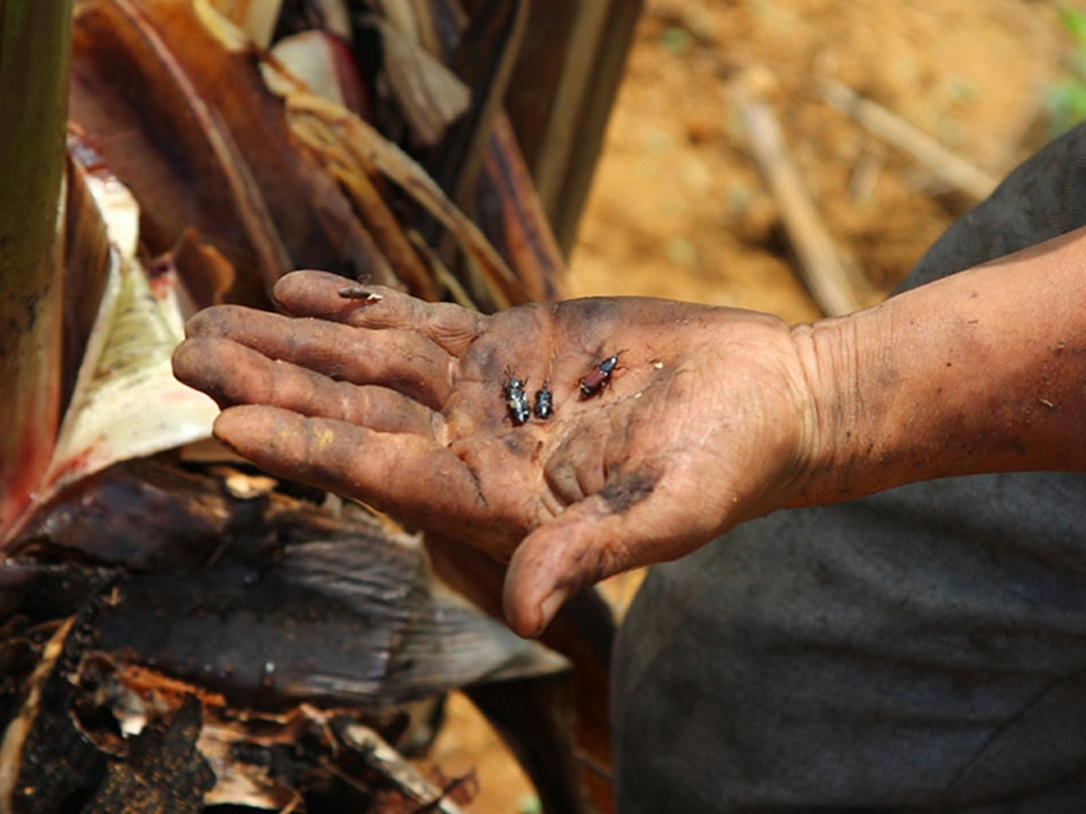
a. Symptoms
Banana plants often exhibit symptoms such as stunted growth, small fruits, drooping and withering leaves, and sometimes entire clusters of bananas falling prematurely. Banana bunches are prone to breaking, and the plants are easily toppled. When the banana plant is split open, white-colored, legless larvae are often found inside, which are plump in appearance.
b. Causes of the Disease
The disease is caused by the burrowing larvae of Cosmopolites sordidus. They belong to the weevil family Curculionidae, order Coleoptera.
c. Disease Transmission
The adult form of these larvae is a long-headed beetle, typically brown-black or gray-black in color, with an oval-shaped body measuring approximately 12-16 millimeters in length and 3-4 millimeters in width, featuring a proboscis about 3 millimeters long. They are active and lay eggs at night, primarily moving by crawling rather than flying. Female adults lay eggs sporadically among leaf sheaths, especially in areas where the sheath or petiole is rotten, or they bore small holes on the outer surface of banana plants, including those already containing or about to contain fruits. Female adults can also burrow into the soil using their sharp proboscis, creating small holes in banana rhizomes to lay eggs, with a lifespan of up to 2 years.
The eggs of the larvae are oval-shaped, about 2 millimeters long, and white. The egg stage lasts approximately 7-8 days. After hatching, the larvae (grubs) are milky white, chubby, and legless, burrowing into the pseudo stems of banana plants, creating longitudinal tunnels within the stem. These tunnels gradually widen and lengthen, and where they exit, a sticky yellowish banana sap may be observed. The larvae leave behind a sawdust-like frass as they progress. Severe infestations can hollow out the plant stems, leading to stem rot, yellowing leaves, wilting, and ultimately plant death. If the plant already has a bunch of bananas, the stem is prone to breaking or the bunch may fall prematurely.
d. Conditions Favoring Infestation
Hot and humid weather conditions provide favorable conditions for larval growth and development.
e. Preventive Measures
Avoid obtaining seedlings from banana plantations affected by the pest. Before planting, remove all rotten leaf sheaths and petioles from the seedlings, collecting and burying or destroying all discarded plant parts. Avoid storing banana seedlings overnight before planting.
Regularly collect and remove rotten, dried, and old leaves, as well as any debris in the plantation. Periodically thin out surplus banana plants to ensure proper ventilation.
For heavily infested plantations, after harvesting, it is recommended to cut the stem close to the ground, dig out the entire rhizome, and dispose of it outside the plantation.
*** Agrifuture recommends the use of insecticide products such as AF - Fenromat 26SC or AF - Metazone 22SC for effective pest prevention and control.
Information on the AF - FENROMAT 26SC product:
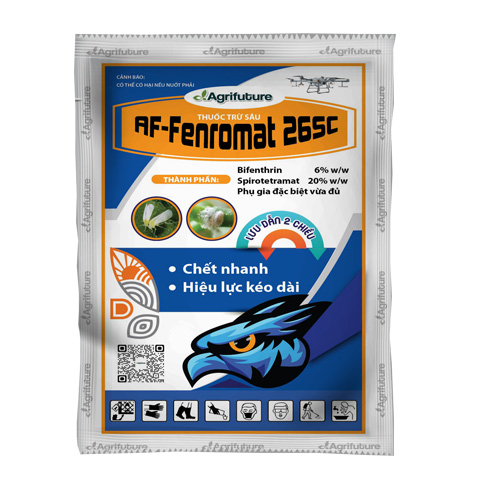
Characteristics and Uses
AF - Fenromat 26SC is formulated from a unique blend of two advanced active ingredients with two powerful, separate mechanisms of insect control. The insecticide directly affects the peripheral nervous system and inhibits ACC, disrupting the lipid synthesis process in insects. Therefore, the insecticide is immediately effective even against resistant pests and remains effective for several days after application.
Usage Instructions
AF - Fenromat 26SC is registered for the control of bollworms on peanuts.
Dosage: 500ml per hectare. Dilute 20ml in a 25-liter water tank.
Water volume: 450 - 500 liters per hectare.
Timing: Apply when bollworms are newly emerged (1 - 2 weeks old). Density should be around 1 - 2 insects per plant.
Re-entry interval: 14 days.
Product information: AF - METAZONE 22SC
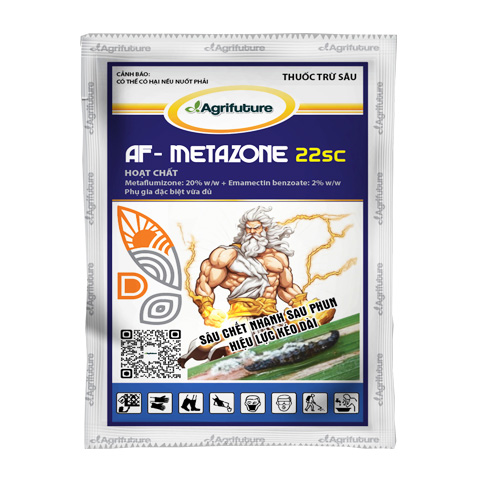
Characteristics and Uses
Af-Metazone 22SC is a new-generation product with the ability to effectively eliminate most types of pesticide-resistant pests through a specialized mechanism. It inhibits muscle contraction, causing a continuous flow to specific GABA and H-Glutamate sites. Additionally, it blocks sodium channels by selectively binding to slow inactive states. Therefore, Af-Metazone 22SC is fundamentally different and superior to other similar products.
Usage Guidelines
Af-Metazone 22SC is registered for the control of bollworm on cotton.
Dosage: 0.5 liters per hectare. Mix 20ml with 25 liters of water. Application rate: 500 liters per hectare.
Application Timing: Spray when pests first appear (1-2 weeks old). Density: about 1-2 pests per plant.
Re-entry Interval: 7 days.
2.Soft-bodied insects
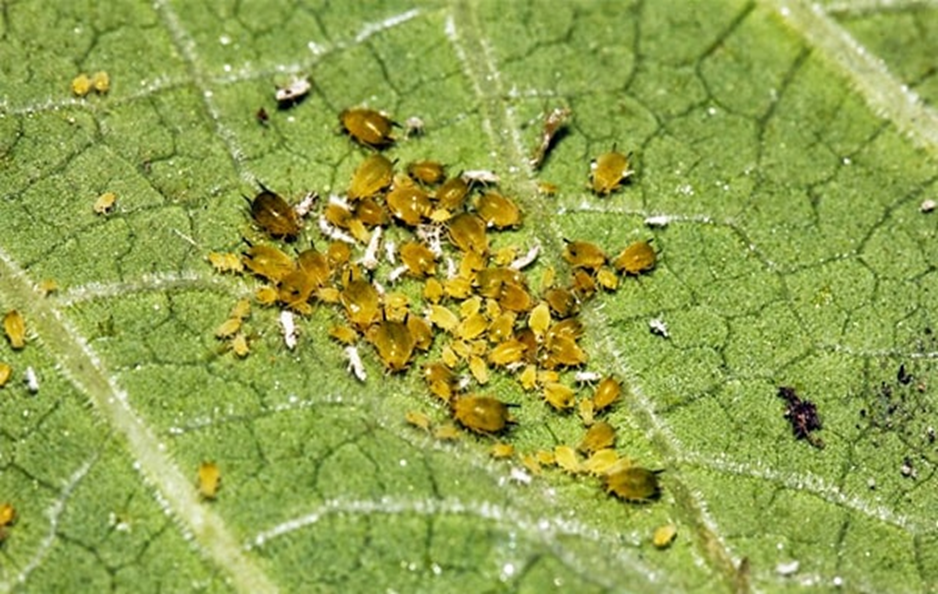
a. Symptoms
Soft rot typically appears at the base of banana stems or in the older leaves near the ground. The rot usually hides under the dry leaf sheaths of partially dried banana stems. Observing banana plants, you may notice clustered, erect leaves with short petioles that are easily torn. Severe infestation results in stunted banana plants, either with no fruit or unripe fruit.
b. Cause of the Disease
The soft rot is caused by the soft scale insect Pentalonia nigronervosa. These insects are very small, about 1mm long, and dark brown in color.
c. Disease Transmission
The soft scale insects feed on plant sap, capable of transmitting banana bunchy top virus to plants. Their excretions attract sooty mold fungus, which further affects the plant's productivity.
d. Conditions for Occurrence and Damage
Soft scale insects are commonly found at the base of banana stems or in older leaves near the ground. They typically hide under the dry leaf sheaths of partially dried banana stems. This species is also present on young banana plants just emerging from the ground. During high infestations, they can be found on the plant tips, within unopened leaves, and even on rolled leaf petioles. The growth cycle of soft scale insects can last 10-15 days, with adult insects capable of living 8-26 days.
e. Prevention Measures
Maintain a clean garden by removing weeds and applying appropriate fertilizers. Detecting the disease early allows for timely removal of infected plants from the garden. Use natural enemies such as ladybugs, predatory mites, ants, spiders, and parasitic wasps.
Agrifuture recommends using the product Promathion 55WG for effective prevention and treatment of this pest.
Information on the product PROMATHION 55WG:
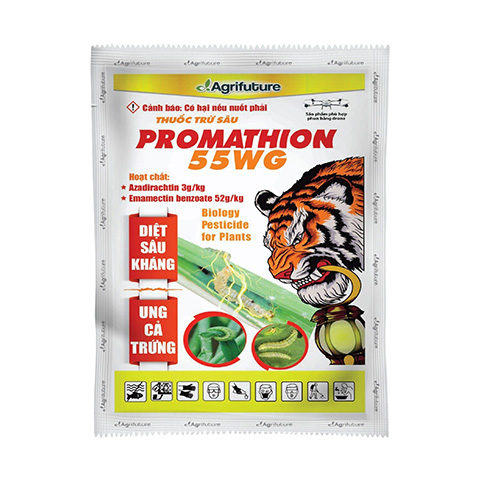
Characteristics and Uses
Promathion 55WG contains the active ingredients of the new generation biological insecticides Azadirachtin and Emamectin benzoate. These two active ingredients have contact, stomach poison, systemic, and residual action, effectively controlling various harmful insects to crops such as caterpillars, leafhoppers, aphids, mites, thrips, and beetles.
The product is safe for natural enemies and for agricultural practices.
Instructions for Use
TVG20 565EC is registered for controlling wax scale insects on coffee plants.
Concentration: 0.12 - 0.15%
Mixing method: Mix 150ml with 200 liters of water.
Application timing: Spray when the scale insects first appear, around 5 - 7 insects per fruit cluster. Spray evenly to cover the crop foliage.
For irrigation: Mix 1ml with 2 liters of water, irrigate at the base.
Re-entry interval: 14 days after spraying.